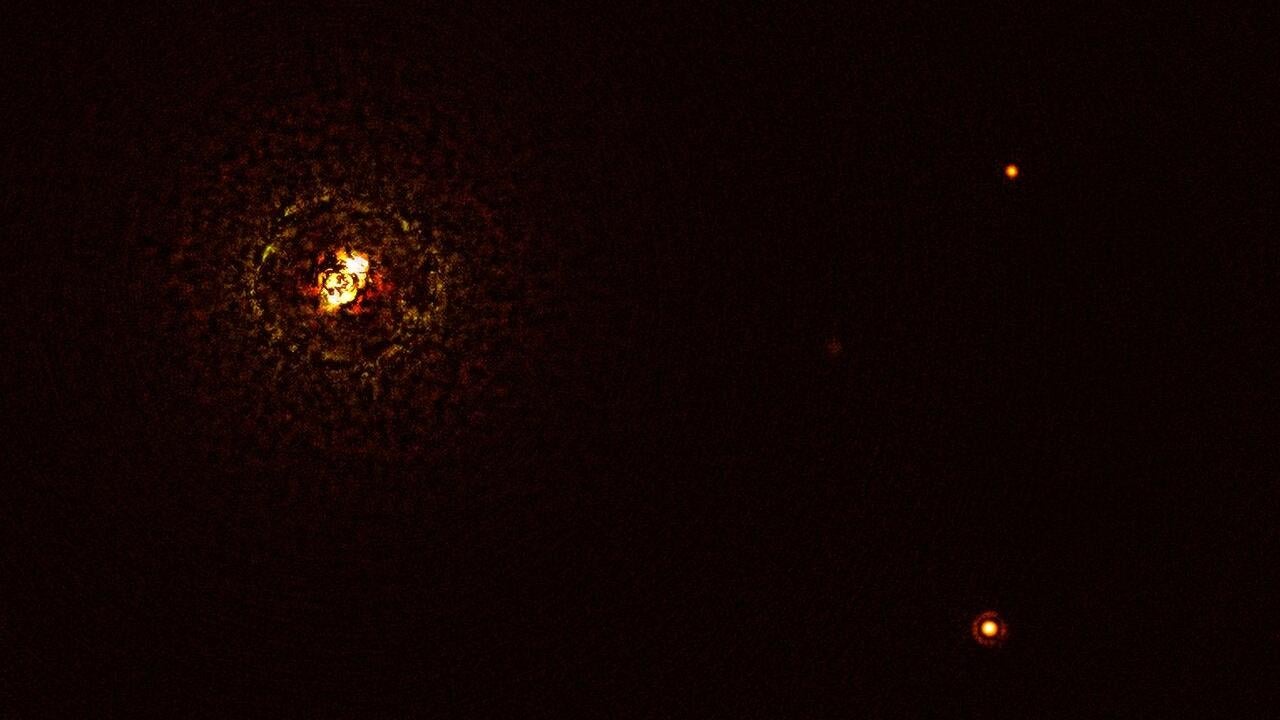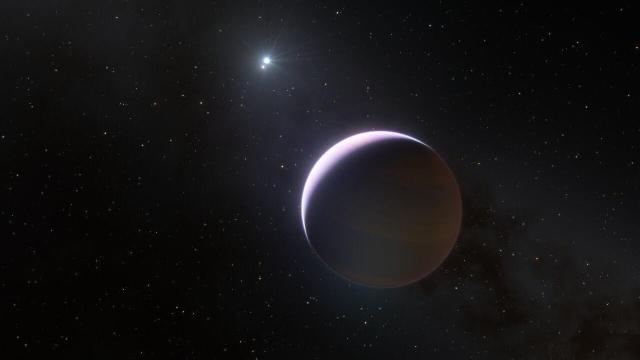Scientists have spotted an unusually large exoplanet in orbit around b Centauri, a massive two-star system that is visible to the unaided eye. With a combined weight of roughly 10 Suns, it’s now the heaviest star system known to host a planet.
Let’s get right to the nitty-gritty of this discovery, the details of which were published today in Nature. The newly discovered planet, called “b Cen (AB)b,” is likely a gas giant and is heavier than 10 Jupiters combined, making it one of the most massive planets ever discovered. It orbits the b Centauri binary system, which is located 325 light-years from Earth and has a combined mass of nearly 10 Suns. At 52 billion miles from its host stars, this planet has one of the widest orbits ever detected. By comparison, Pluto orbits the Sun at around 3.3 billion miles, so yeah, that’s an unbelievable separation.
Until now, planets had not been found in orbit around star systems weighing more than three solar masses. Astronomers didn’t think planets could form around systems like this, so it’s forcing a major rethink of what’s possible in terms of planetary architectures and the conditions under which planets can form. Markus Janson, an astronomer at Stockholm University and the first author of the study, said the thing that excites him most about this discovery is the “astounding diversity” of exoplanetary systems.
“It seems that no matter where we look — around small or big stars, single stars or binary stars, alive stars or dead stellar remnants — we always find planets in some form, even in places we didn’t think possible,” he wrote in an email.
That a planet exists in this star system is indeed surprising. Young stars have protoplanetary disks around them, from which planets eventually emerge. A hot star system like b Centauri, however, is not supposed to be conducive to planetary formation, owing to tremendous amounts of ultraviolet and X-ray radiation. This high-energy radiation “tends to destroy the disks in a very short time,” and it was “thought that this wouldn’t give planets enough time to form in the disk before it disappeared,” Janson said. Yet there it is — a full fledged planet around the b Centauri system.

Janson and his colleagues spotted b Cen (AB)b with the SPHERE exoplanet imager at the European Southern Observatory’s Very Large Telescope in Chile, on March 20, 2019 and then again on April 10, 2021. The astronomers used a high-contrast imaging technique to detect the planet, in which they distinguished the faint light coming from the planet from the very bright light coming from the star system itself.
A deformable mirror on SPHERE that can rapidly change shape counteracted blurring effects caused by Earth’s atmosphere, while a chronograph blocked excessive light coming in from the source target. A special technique, known as Angular Differential Imaging, ruled out extraneous optical effects. Interestingly, follow-up work showed that the planet was observed 20 years ago by a different ESO instrument, but it wasn’t properly identified at the time.
A neat observation is how the ratio between the masses of the star system and its planet closely matches that of our Sun and Jupiter. But that’s where the comparison ends, as the scale of b Centauri is far vaster, as the planet is 10 times the mass of Jupiter and with an orbit that’s 100 times wider.
I asked Janson if b Cen (AB)b might actually be a brown dwarf (a so-called failed star), or if it qualifies as a new kind of planet altogether. Brown dwarfs “would be hotter than what we observe, so we can exclude that option,” he replied, but a “new class of planets is a possibility,” he added, saying astronomers “would have to study a larger sample of similar systems before we can say something conclusive about that.”
The team is currently running a survey called BEAST, which is scanning 85 stars with characteristics similar to b Centauri. BEAST could show us how common these sorts of planets might be, while also shedding light on how they might form.
“The discovery of the planet in the b Centauri system and any other future results from BEAST will provide input for planet formation theorists to refine their theories, and hopefully find the physics that allow for the wide range of planets that are observed, both around massive stars and simultaneously around more Sun-like and smaller stars,” Janson said.
From an astrobiological perspective, Janson said b Centauri is “possibly one of the worst places in the galaxy to host life.” Together, the binary pair spew enormous amounts of UV and X-ray radiation, “which would sterilise any surface that is exposed to it,” so “life on any surface in the system is certainly not very likely.” Still, Janson did not rule out the possibility that life could exist in subterranean oceans, matching ongoing speculation about basic life existing on Jupiter’s moon Europa or Saturn’s moon Enceladus.
Ultimately, the new discovery “provides us with a new important piece of the puzzle as to how planets form, which is an understanding that we need to have if we are to understand where we come from and how we fit into the universe at large,” Janson said.
